Breast health is important for women of all ages. Breast cancer is the most common cancer among women worldwide, and early detection is key to successful treatment. In this article, we will discuss the importance of breast health, how to perform breast self-exams, and when to seek medical attention.
Breast Self-Exams
Performing breast self-exams is an important part of maintaining breast health. This simple, at-home exam can help women detect changes in their breast tissue, such as lumps or changes in size or texture. Here are the steps for performing a breast self-exam:
- Look in the mirror: Start by looking at your breasts in the mirror with your arms at your sides. Look for any changes in the shape, size, or color of your breasts.
- Raise your arms: Next, raise your arms above your head and look for any changes in the shape or size of your breasts.
- Check for nipple discharge: Gently squeeze each nipple to check for any discharge.
- Feel for lumps: Finally, lie down and use your fingertips to feel for lumps or changes in your breast tissue. Start at the outer edge of your breast and work your way in, using a circular motion. Be sure to check the entire breast, including the area under your armpit.
It is recommended that women perform breast self-exams once a month, preferably a few days after their period ends.
Mammograms
Mammograms are another important tool for detecting breast cancer early. A mammogram is an X-ray of the breast tissue that can detect lumps or changes in the breast tissue that may not be noticeable during a breast self-exam. It is recommended that women between the ages of 40 and 75 get a mammogram every one to two years.
Breast Cancer Risk Factors
Certain factors can increase a woman’s risk of developing breast cancer. These include:
- Age: The risk of breast cancer increases as women get older.
- Family history: Women with a family history of breast cancer are at a higher risk.
- Hormones: Women who have had long-term exposure to estrogen, such as those who started their periods early or went through menopause later in life, are at a higher risk.
- Obesity: Women who are overweight or obese are at a higher risk.
- Alcohol consumption: Women who drink alcohol regularly are at a higher risk.
- Lack of physical activity: Women who are not physically active are at a higher risk.
When to Seek Medical Attention
It is important to seek medical attention if you notice any changes in your breast tissue, such as lumps, changes in size or texture, or discharge from the nipple. These changes may not necessarily indicate breast cancer, but it is important to get them checked out by a healthcare provider.
If you have a family history of breast cancer or other risk factors, you may want to discuss your risk with your healthcare provider and develop a plan for regular screenings.
Conclusion
Maintaining breast health is important for women of all ages. Breast self-exams and mammograms are important tools for detecting breast cancer early. Women should perform breast self-exams once a month and get a mammogram every one to two years. Certain factors, such as age, family history, and lifestyle factors, can increase a woman’s risk of developing breast cancer. It is important to seek medical attention if you notice any changes in your breast tissue and to discuss your risk with your healthcare provider.

